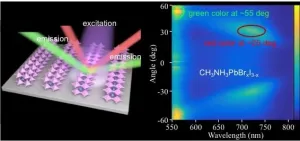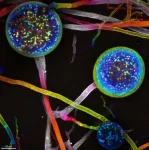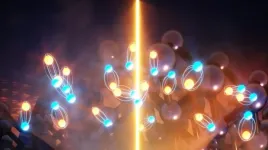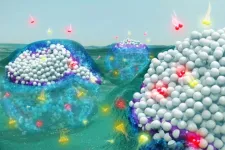Large-area periodic perovskite nanostructures for lenticular printing laser displays
2021-02-04
(Press-News.org) Lead halide perovskites, with high refractive index and excellent optoelectronic property, have been used in both constructing high-quality optical resonators/lasers and fabricating high-efficiency light-emitting devices for advanced displays. Lenticular printing provides an illusion of depth and shows varying images upon view angles, which is considered as a promising approach towards future stereoscopic displays. To realize lenticular-printing-based display, it is required to modulate the outcoupling direction of emission light rather than that of incident light. Ideally, the lenticular-lens-like structures would be integrated into the active layer of light-emitting devices. Therefore, the hybrid perovskite becomes a promising candidate for the investigation of lenticular printing display; however, it remains a challenge to realize large-area periodic structures of perovskite materials especially with a feature size of wavelength scale.
Very recently, Dr. Chuang Zhang, Dr. Yong Sheng Zhao from Institute of Chemistry, Chinese Academy of Sciences, Dr. Yuchen Wu from Technical Institute of Physics and Chemistry, Chinese Academy of Sciences, and their colleagues fabricated lead halide perovskite periodic structures via a space-confined solution growth method. The spatial resolution could be down to hundreds of nanometers while the substrate size up to several centimeters. These structures were able to not only modulate the reflection of visible light, but also control the angle of light emission from hybrid perovskites. More importantly, the low-threshold lasing based on distributed feedback was observed from the periodic structures, and its narrow line-width offered possibility to realize the lenticular printing laser display, according to the wavelength-dependent outcoupling of emission colors. A prototype of laser display panels was then realized based on the mixed halide perovskites, in which the green and red colored images were obtained at high and low angles respectively. This work would shed light on the design and fabrication of perovskites materials for new types of display techniques.
INFORMATION:
See the article: Wang M, Li H, Dai C, Tang J, Yin B, Wang H, Li J, Wu Y, Zhang C, Zhao YS. Large-area periodic lead halide perovskite nanostructures for lenticular printing laser displays. Sci. China Chem., 2020, DOI: 10.1007/s11426-020-9919-6.
https://engine.scichina.com/publisher/scp/journal/SCC/doi/10.1007/s11426-020-9919-6?slug=fulltext
[Attachments] See images for this press release:

ELSE PRESS RELEASES FROM THIS DATE:
2021-02-04
Researchers at Baylor College of Medicine found that while most individuals responded to respiratory syncytial virus (RSV) natural reinfection with a typical sustained antibody response associated with protection, a few individuals surprisingly responded atypically, not being able to sustain the antibody response, which declined to levels that made the individuals susceptible to RSV reinfection.
The researchers highlight in their study, published in the journal Vaccine, that their findings point at a subpopulation of people who also may not maintain an antibody response to vaccines and suggest the need to characterize patient-specific responses to respiratory viral infections, such as COVID-19.
"RSV is ...
2021-02-04
Anyone who's been to a concert knows that something magical happens between the performers and their instruments. It transforms music from being just "notes on a page" to a satisfying experience.
A University of Washington team wondered if artificial intelligence could recreate that delight using only visual cues -- a silent, top-down video of someone playing the piano. The researchers used machine learning to create a system, called Audeo, that creates audio from silent piano performances. When the group tested the music Audeo created with music-recognition ...
2021-02-04
Researchers from the University of Ottawa have discovered that plants may be able to control the genetics of their intimate root symbionts - the organism with which they live in symbiosis - thereby providing a better understanding of their growth.
In addition to having a significant impact on all terrestrial ecosystems, their discovery may lead to improved eco-friendly agricultural applications.
We talked to research lead Nicolas Corradi, Associate Professor in the Department of Biology and Research Chair in Microbial Genomics at the University of Ottawa, ...
2021-02-04
LA JOLLA, CA--As the opioid epidemic raged on with an even greater force during COVID-19, the Scripps Research laboratory of chemist Kim Janda, PhD, has been working on new therapeutic interventions that may be able to prevent the bulk of deaths from opioid overdose.
Janda and his team have developed experimental vaccines that have shown in rodents to blunt the deadly effects of fentanyl--which has been driving the boom in opioid deaths--as well as its even more fatal cousin, carfentanil, a growing source of overdoses and a chemical terrorist threat.
"Synthetic opioids are not only extremely deadly, but also addictive and easy to manufacture, making them a formidable public health threat, especially when the coronavirus crisis is negatively impacting mental health," says Janda, the Ely ...
2021-02-04
A team of researchers led by Columbia University has developed a unique platform to program a layered crystal, producing imaging capabilities beyond common limits on demand.
The discovery is an important step toward control of nanolight, which is light that can access the smallest length scales imaginable. The work also provides insights for the field of optical quantum information processing, which aims to solve difficult problems in computing and communications.
"We were able to use ultrafast nano-scale microscopy to discover a new way to control our crystals with light, turning elusive photonic properties on and off at will," said Aaron Sternbach, postdoctoral researcher ...
2021-02-04
Army scientists evaluated three nonhuman primate species as potential models of SARS-CoV-2 airborne infection, according to results published online this week in PLOS ONE. Their work demonstrates that any of these species may be useful for testing vaccines and therapies in response to the COVID-19 pandemic, which has resulted in over 104 million cases and more than 2 million deaths worldwide in the past year.
Given the global impact of COVID-19, experts are working rapidly to develop medical countermeasures, and testing in animal models is critically important to evaluate the efficacy of these products. Recent studies suggest that aerosol ...
2021-02-04
Philadelphia, February 4, 2021 - Researchers have leveraged the latest advances in RNA technology and machine learning methods to develop a gene panel test that allows for highly accurate diagnosis of the most common types of liposarcoma. It quickly and reliably distinguishes benign lipomas from liposarcomas and can be performed in laboratories at a lower cost than current "gold standard" tests. The new assay is described in The Journal of Molecular Diagnosis, published by Elsevier.
"Liposarcomas are a type of malignant cancer that is difficult to diagnose because, even under a microscope, it is hard to differentiate liposarcomas from benign tumors or other types ...
2021-02-04
An assessment published this week in the journal The Lancet HIV provides new insight about an initiative to integrate treatment of opioid use disorder along with HIV in Vietnam.
The study marks one of the first scientifically robust assessments of a new model of treating HIV in lower or middle income countries where injection drug use is a major cause of HIV infection. It also suggests the importance of building support for peer and community connections to tackle the opioid epidemic that continues to ravage the United States in the midst of the COVID-19 pandemic.
The study was led by scientists and physicians at Hanoi Medical University and Oregon Health & Science University.
"Our study suggests that countries that ...
2021-02-04
WOODS HOLE, Mass. -- Egg cells start out as round blobs. After fertilization, they begin transforming into people, dogs, fish, or other animals by orienting head to tail, back to belly, and left to right. Exactly what sets these body orientation directions has been guessed at but not seen. Now researchers at the Marine Biological Laboratory (MBL) have imaged the very beginning of this cellular rearrangement, and their findings help answer a fundamental question.
"The most interesting and mysterious part of developmental biology is the origin of the body axis in animals," said researcher Tomomi Tani. An MBL scientist in the Eugene Bell Center at the time of the research, Tani is now with Japan's National Institute of Advanced Industrial Science and Technology.
The work by Tani and ...
2021-02-04
CHAMPAIGN, Ill. -- Chemical manufacturers frequently use toxic solvents such as alcohols and benzene to make products like pharmaceuticals and plastics. Researchers are examining a previously overlooked and misunderstood phenomenon in the chemical reactions used to make these products. This discovery brings a new fundamental understanding of catalytic chemistry and a steppingstone to practical applications that could someday make chemical manufacturing less wasteful and more environmentally sound.
The study led by University of Illinois Urbana-Champaign researcher David Flaherty, University of Minnesota, Twin Cities researcher Matthew Neurock and Virginia Tech researcher Ayman Karim is published in the journal Science.
Combining ...
LAST 30 PRESS RELEASES:
[Press-News.org] Large-area periodic perovskite nanostructures for lenticular printing laser displays




